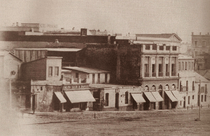José Canaveris
| Juan José Canaveris | |
|---|---|
| Official in Buenos Aires Cabildo | |
|
In office 1801–1822 | |
| Personal details | |
| Born |
Juan Joseph Ramón Jugluns de Canaveris January 19, 1780 Buenos Aires, Viceroyalty of the Rio de la Plata |
| Died |
October 18, 1837 Buenos Aires, Argentina |
| Nationality | Argentine |
| Spouse(s) | Agustina Denis (1785–1823) |
| Occupation |
Politician teacher farmer |
| Profession |
Attorney.[1] Accountant |
| Religion | Catholicism |
Juan José Canaveris (1780–1837) was an Argentine politician, military, notary, prosecutor and accountant of Buenos Aires. In 1809 he was honored by the Junta Suprema de Sevilla, for his heroic participation in the defense of Buenos Aires, during the English invasions in the Río de la Plata.[2]
Biography

.jpg)
José Canaveris was born in Buenos Aires, son of Juan Canaveris and Catalina Bernarda de Esparza. In 1800, he was married in the Catedral Metropolitana de Buenos Aires with Agustina Denis, daughter of Juan Denis and María Silva, criollos, descendants of settlers from Ireland, Spain and Portugal. Agustina Denis was aunt of Francisco Crespo y Denis, son of his sister Catalina Denis.
Canaveris and his wife had several children, born between 1801 and 1820,[3] including María Juana, Juan Manuel, José María, Manuel José, María de la Candelaria, Patricia, Feliciano, Gerónimo Emiliano and María Donata.[4] A son, Juan Manuel Canaveris was prosecutor during in the early days of Government of Juan Manuel de Rosas, but then he was forced into exile in Montevideo.[5]
José Canaveris was neighbor of Vicente Anastasio Echevarría, had his house one block from the church La Merced, in the neighborhood of San Nicolás.[6] His paternal ancestors were known notaries and lawyers of the Piedmont, that like his father were employees of the Court of Auditors.[7]
Career
Jose Canaveris began his career as government official in the early of 1800s. And was appointed as notary at the Court of Auditors in 1810.[8] During the British invasions of the Río de la Plata, he joined the criollas militias, where was assistant of the battalion of Quinteros and Labradores in 1807.[9] The January 13, 1809 the Supreme Junta of Seville decided on behalf of the king Ferdinand VII, reward the officers of the various organs of the militia, giving the rank of Captain to José Canaveris.[10]
After the British invasion, Canaveris continues to serve on the Council as notary, accountant and served in the Junta de Observación.[11] In 1820 was appointed official of the Junta de Representantes, and member of Comisaría de Guerra, (commissariat of war).[12] Canaveris also devoted much of his time to teaching, especially in the primary education. He had opened some schools in the city,[13] her brother Mariano Canaveris (1783-1840s) was a schoolmaster in Olivos, Buenos Aires Province.[14]
Canaveris was involved in political conflicts between federales and unitarios, during a visit to Governor of Buenos Aires don Juan José Viamonte, a group of bandits had opened fire on the house of Viamonte. At that meeting between Viamonte and Canaveris, had also participated Miguel de Azcuénaga and Gervasio Espinosa.[15] Canaveris also suffered persecution during the government of Juan Manuel de Rosas,[16] his son Feliciano Canaveris had been assassinated by order of Manuel Oribe (murder occurred in January 1843, in the Tacuarembó Department, Uruguay).[17]
In 1829 were transferred the remains of Manuel Dorrego from Navarro to be deposited in the La Recoleta Cemetery, José Canaveris, his son Juan Manuel Canaveris and Miguel de Azcuenaga, had participated in the military escort.[18]
In 1835, Canaveris posted a notice in the newspaper British Packet, and Argentine News, where offered his services of lawyer and accountant to the British community in Buenos Aires.[19]
Their descendants were partners in the Shipping agency: Duffy Canaveris and Lerena, Company located in San Martín street, neighborhood of San Nicolás (his birthplace).[20]
References
- ↑ Ley, justicia y revolución en Buenos Aires, 1810–1830 (PDF), Magdalena Candioti
- ↑ Historia general de las antiguas colonias hispano-americanas ..., Volumen 3, Argentina
- ↑ Revista del Instituto de Estudios Genealógicos del Uruguay, Números 13–17, El Instituto, 1991
- ↑ Bautismos en Buenos Aires, FamilySearch
- ↑ Inventario de los fondos documentales del Archivo General de la Nación, Volúmenes 1–2, Uruguay. Archivo General de la Nación
- ↑ Gaceta de Buenos Aires (1810–1821), Trapalanda:biblioteca digital
- ↑ Raccolta degli atti del governo di S.M. il Re di Sardegna dall ..., Volume 1, By Sardinia (Kingdom)
- ↑ Genoese Trade and Migration in the Spanish Atlantic, 1700–1830, Catia Brilli
- ↑ Tomas de razón de despachos militares, cédulas de premio, retiros, empleos civiles y eclesiásticos, donativos, etc., 1740 a 1821, G. Kraft, impresor, 1925
- ↑ Invasiones inglesas al Río de la Plata 1806–1807, Marcos de Estrada
- ↑ Acuerdos del extinguido Cabildo de Buenos Aires, Talleres gráficos de la Penitenciaria nacional, 1930
- ↑ Tomas de razón de despachos militares, Archivo General de la Nación (Argentina)
- ↑ Cuarto Congreso Internacional de Historia de América, Academia Nacional de la Historia, 1966
- ↑ La escuela pública bonaerense hasta la caída de Rosas, Evaristo Iglesias
- ↑ Unitarismo, federalismo, rosismo, Ediciones Pannedille, 1972
- ↑ Amalia, José Mármol
- ↑ Montevideo: Apuntes históricos de la defensa de la república, Volumen 1, Uruguay
- ↑ El Lucero, diario político, literario y mercantil (1829–1833). (PDF), Imprenta Argentina (Acervo Digital)
- ↑ Notice, British Packet, and Argentine News No. 467 (Trapalanda digital)
- ↑ Commercial directory of the American republics, :, Washington, : Gov't print. off.
External links
- familysearch.org
- familysearch.org
- familysearch.org
- familysearch.org
- Guia de la Ciudad 1833 – archive.org
- Registro nacional de la República Argentina – Digital Library